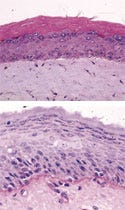Automation Fits Like A Second Skin
February 1, 2009
R&D DIGEST
|
Shown here is a cross-section of artificial skin (top) compared with human skin (bottom). Both are made up of three layers. |
Although people are told to love the skin they're in, up until now, there wasn't much choice. Now, getting a new one could become much easier. Researchers at the Fraunhofer Institute for Interfacial Engineering and Biotechnology (IGB; Stuttgart, Germany) are experimenting with ways to fully automate the production of artificial tissue. Such a process would be especially beneficial to burn victims and others who require skin transplants.
Currently, skin transplants use a patient's own skin and are painstaking procedures that typically require multiple operations, but artificial skin could ease the process. Cartilage and skin tissues are already cultured in biotechnology laboratories, but there is very little automation involved.
“Until now, methods of culturing tissue like that used for skin transplants have been very expensive,” says Heike Mertsching, leader of this project and the department of cell and tissue engineering at the institute. In part, tissue culturing methods have been so costly because the work is manual. In addition, Mertsching says, “[Manual production] means that the process is not particularly efficient.”
Imagine the process: a sample of human tissue is checked for sterility. Then, a gripping device carries the sample to an automated machine that performs several individual tasks. The device cuts the sample into tiny pieces, isolates different cell types, stimulates cell growth, and then mixes the skin cells with collagen. A custom gel matrix helps produce a 3-D reconstruction of the different skin layers. Finally, the device packages the cells for shipment. If there is no immediate use for the artificial skin, it can be deep-frozen and stored for later.
Researchers at IGB have partnered with colleagues at other Fraunhofer institutes to come up with a novel conceptual design. The other groups involved are the Fraunhofer Institutes for Production Technology; Manufacturing, Engineering, and Automation; and Cell Therapy and Immunology. Prototypes may come as early as this spring.
“During 2009, we want to develop the first prototypes. We [plan to] show some prototypes at the [BIO International Convention] in May in Atlanta,” Mertsching says. In the meantime, the researchers are looking for additional applications. “We're trying to adapt the technology for the generation of other tissues like the cornea, which can be used as an alternative to animal studies.”
Copyright ©2009 Medical Device & Diagnostic Industry
About the Author(s)
You May Also Like


.png?width=300&auto=webp&quality=80&disable=upscale)
